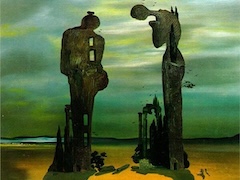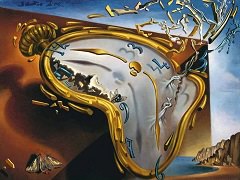Rhinocerotic Figure of Phidias's Illisos, 1954 by Salvador Dali

This comes from what Dali described as his 'almost divine and chaste rhinoceros-horn period', when he claimed that the curve of the beast's horn was the only perfect logarithmic spiral and consequently the ultimate in formal perfection. With characteristic Daliesque logic - or critical paranoia - this insight came to him while he was copying a canvas that had obsessed him for decades: the cool, lovely, light-filled portrait of The Lacemaker by Vermeer.
In the mid-1950s Dali even made a film called The Prodigious Story of the Lacemaker and the Rhinoceros, starring himself, a reproduction of the Johannes Vermeer, and a life, if carefully fenced-off, rhino. Here a torso from the Parthenon by the most famous of ancient Greek sculptors, Phidias, is fragmenting into a rhino head and horn-shapes which hang above a typical Dali seascape, which is in turn suspended over the sea-bed.























